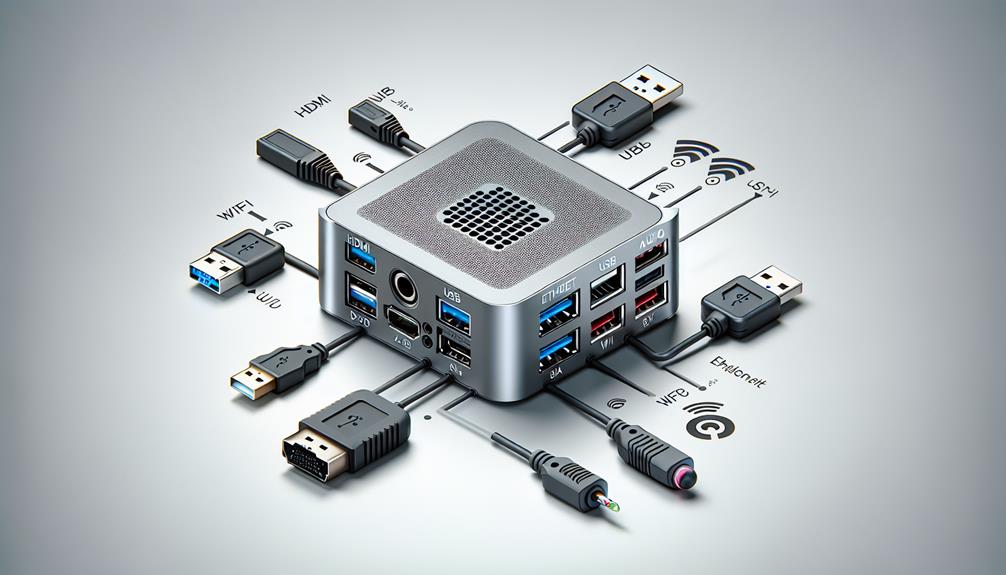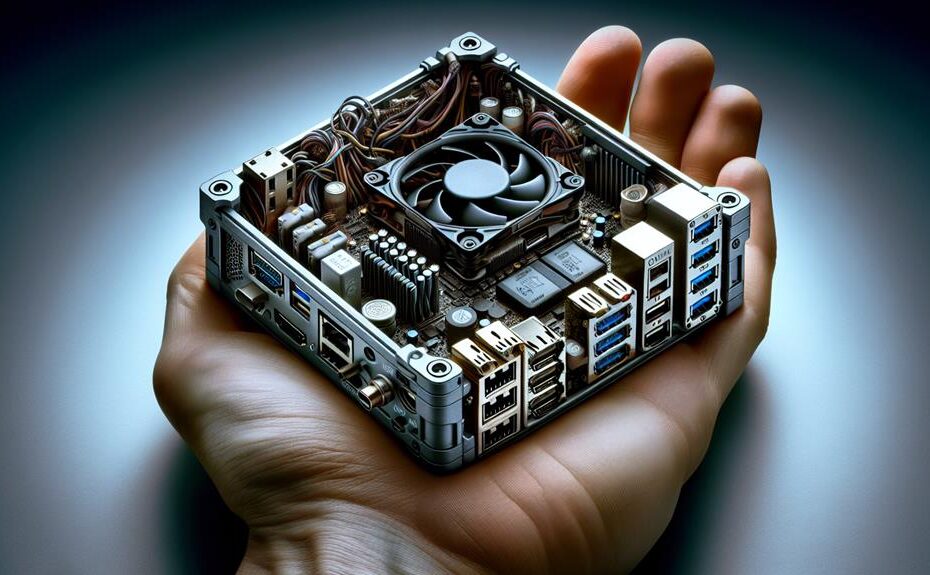



In a mini PC, the motherboard integrates important components like the processor, memory, storage, and connectivity interfaces. This integration serves as the central hub for communication. To guarantee efficiency, low-power processors and effective cooling systems are essential. The CPU determines processing power, and thermal management is critical for performance. Memory, including RAM and cache memory, provides fast data access. Storage options like SSDs and HDDs balance speed and capacity. Operating systems impact performance, while connectivity options such as Wi-Fi and multiple ports enhance productivity and entertainment. Understanding these components is key to maximizing your mini PC's potential.
Key Takeaways
- Mini PC components like processor, memory, and storage are integrated on a motherboard for central communication.
- Processing power is determined by the CPU; efficient thermal management and power consumption optimize performance.
- Memory (RAM) and storage (SSD/HDD) provide fast data access and balance speed with capacity.
- Operating system selection impacts performance; compatibility and configuration influence smooth operation.
- Connectivity options like Wi-Fi, Bluetooth, USB, HDMI, and more enhance productivity and entertainment possibilities.
Mini PC Components
Mini PC components comprise the essential hardware elements that collectively enable the functionality of these compact computing devices. One critical aspect is the motherboard integration, where all the key components such as the processor, memory, storage, and connectivity interfaces are interconnected. The motherboard serves as the central hub that allows these parts to communicate effectively, ensuring smooth operations within the limited space of a mini PC.
Another important factor to take into account in mini PC components is power efficiency. Due to their compact size, mini PCs need to optimize power consumption to maintain performance while staying cool. Components like low-power processors, efficient cooling systems, and power-saving features integrated into the motherboard contribute to the overall power efficiency of the system. This emphasis on power efficiency not only helps in reducing energy consumption but also plays a crucial role in ensuring the stability and longevity of the mini PC's operation.
Processing Power
To understand the operational capability of a mini PC, it is imperative to evaluate its processing power, which directly influences its performance in handling various computing tasks efficiently. The processing power of a mini PC is determined by its CPU (Central Processing Unit). When gauging processing power, factors such as thermal management and power consumption play a critical role. Efficient thermal management is essential to prevent overheating, ensuring peak performance. Mini PCs often prioritize power efficiency to balance performance and energy consumption.
Performance benchmarks are used to measure the processing power of mini PCs accurately. These benchmarks evaluate the CPU's speed, multitasking capabilities, and overall performance under different workloads. Cooling solutions are crucial for maintaining consistent performance levels. Mini PCs utilize various cooling solutions like fans, heat sinks, and even liquid cooling systems to dissipate heat effectively.
Memory and Storage

Efficient operation of a mini PC relies heavily on the ideal configuration and management of its memory and storage components. Memory organization plays a vital role in the performance of a mini PC. Random Access Memory (RAM) provides fast access to data the CPU needs to operate, while the Cache memory stores frequently used data for quicker retrieval. The organization of memory modules and their capacity directly impacts the speed and multitasking capabilities of the mini PC.
When it comes to storage types, Mini PCs typically utilize Solid State Drives (SSDs) or Hard Disk Drives (HDDs). SSDs offer faster read/write speeds and are more durable due to their lack of moving parts, making them ideal for quick boot times and program launches. On the other hand, HDDs provide higher storage capacities at a lower cost but are slower in performance compared to SSDs. Mini PCs often incorporate a combination of SSDs and HDDs to balance speed and storage capacity for best performance. Proper management of memory and storage guarantees smooth operation and efficient multitasking on a mini PC.
Operating System
The best performance of a mini PC depends heavily on the selection and configuration of its operating system. When choosing an operating system for your mini PC, it is important to take into account the system requirements and software compatibility to guarantee efficient functionality.
System requirements play a significant role in determining which operating system is suitable for your mini PC. Different operating systems have varying demands in terms of processing power, memory, and storage. It is essential to select an operating system that aligns with the capabilities of your mini PC to avoid performance issues and ensure smooth operation.
Moreover, software compatibility is another critical aspect to take into account when selecting an operating system for your mini PC. Make sure that the operating system you choose supports the applications and programs you intend to use. Compatibility issues can arise if the operating system does not support specific software, leading to functionality limitations and potential performance bottlenecks. By carefully assessing system requirements and software compatibility, you can optimize the performance of your mini PC.
Connectivity Options

Explore the different connectivity options available to enhance the functionality and utility of your mini PC. Mini PCs come equipped with a range of connectivity features that can greatly expand their capabilities. When it comes to wireless capabilities, most mini PCs are equipped with Wi-Fi and Bluetooth connectivity, allowing you to easily connect to the internet and peripheral devices such as keyboards, mice, and headphones.
In terms of peripheral compatibility, mini PCs typically offer a variety of ports including USB, HDMI, DisplayPort, and audio jacks. These ports allow you to connect external storage devices, monitors, speakers, and other peripherals to customize your setup based on your needs. The port selection is an important factor to take into account when selecting a mini PC to ensure compatibility with your existing devices.
Furthermore, mini PCs often support multiple display options, enabling you to connect to various monitors or TVs for enhanced productivity or entertainment purposes. Whether you need a dual monitor setup for work or want to enjoy multimedia content on a larger screen, the display options available on mini PCs cater to diverse user requirements.
Disclosure: As an Amazon Associate, I earn from qualifying purchases.




